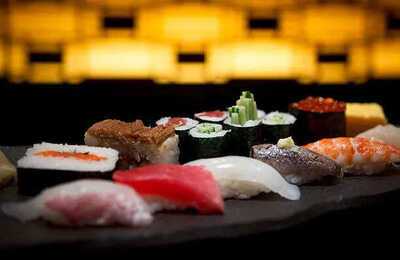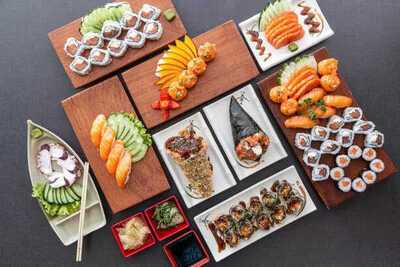Most cuisines kick off with oil in a hot pan. Japanese cooking usually begins with water — or a light broth made from kombu (seaweed), mushrooms, or dried fish. This single shift changes everything. Instead of frying, the food is simmered, steamed, or poached. It keeps flavours clean and meals easier to digest. That’s one big reason why Japanese food feels light, yet somehow satisfying.
But the health benefits aren’t just about skipping oil. Japanese food takes a balanced approach, where nothing is overdone. It isn’t obsessed with being “low carb” or “sugar-free.” It just leans on smart choices, clean techniques, and tradition that has lasted because it works. Here’s what else makes this one of the world’s most quietly effective ways of eating:
Meals are built on variety, not volume

A typical Japanese meal isn’t about one big main dish. It’s a mix of small, simple things — some rice, a few cooked vegetables, a little grilled fish, miso soup, maybe some pickles or tofu. Nothing is heavy on its own, but together it adds up to a balanced, filling meal. You get what your body needs without feeling weighed down. It’s enough, but never too much.
Fermented foods are part of the everyday table
Miso, soy sauce, pickles, natto — these fermented foods are just normal things people eat in Japan every day. They help with digestion, keep your stomach happy, and make it easier for your body to absorb and use the nutrients from food. Instead of taking probiotics through supplements, the average Japanese meal delivers them naturally, through flavour-rich foods that have been around for centuries.
Fish takes the lead over meat

Japan has always leaned more towards seafood than red meat. Fish like salmon, sardines, and mackerel show up a lot in Japanese meals. They’ve got good fats (omega-3s) that help your heart and brain. The way they’re cooked is super simple — usually just grilled, eaten raw, or lightly simmered. No heavy sauces, no extra oil, just clean, tasty fish. And they don’t overdo it with huge portions either, which keeps the meal light and balanced.
Vegetables are central, not a side note
Japanese meals tend to include several types of vegetables, served in different ways — raw, steamed, simmered, pickled. Seaweed is also common and adds minerals you won’t find in land-based greens. These aren’t coated in cream or fried in batter. They’re served in ways that preserve texture and nutrition. Vegetables aren’t added in to “be healthy.” They’re just part of the meal, always have been.
Meals are paced, not rushed

Food is eaten slowly, with intention. It’s served in separate bowls, eaten with chopsticks, and rarely gulped down. This naturally slows things down. You chew more, taste more, and give your body time to signal when it’s full. There’s no pressure to clear a huge plate. That slower way of eating really helps — not just with digestion, but with how you actually feel about the food you’re eating.
Japanese cuisine doesn’t need to label itself as healthy. It simply is — because of the way it’s cooked, the ingredients it uses, and the habits around how it’s eaten. Meals built on water instead of oil, variety instead of overload, and care instead of shortcuts — that’s what makes it work.
But the health benefits aren’t just about skipping oil. Japanese food takes a balanced approach, where nothing is overdone. It isn’t obsessed with being “low carb” or “sugar-free.” It just leans on smart choices, clean techniques, and tradition that has lasted because it works. Here’s what else makes this one of the world’s most quietly effective ways of eating:
Meals are built on variety, not volume
A typical Japanese meal isn’t about one big main dish. It’s a mix of small, simple things — some rice, a few cooked vegetables, a little grilled fish, miso soup, maybe some pickles or tofu. Nothing is heavy on its own, but together it adds up to a balanced, filling meal. You get what your body needs without feeling weighed down. It’s enough, but never too much.
Fermented foods are part of the everyday table
Miso, soy sauce, pickles, natto — these fermented foods are just normal things people eat in Japan every day. They help with digestion, keep your stomach happy, and make it easier for your body to absorb and use the nutrients from food. Instead of taking probiotics through supplements, the average Japanese meal delivers them naturally, through flavour-rich foods that have been around for centuries.
Fish takes the lead over meat

Japan has always leaned more towards seafood than red meat. Fish like salmon, sardines, and mackerel show up a lot in Japanese meals. They’ve got good fats (omega-3s) that help your heart and brain. The way they’re cooked is super simple — usually just grilled, eaten raw, or lightly simmered. No heavy sauces, no extra oil, just clean, tasty fish. And they don’t overdo it with huge portions either, which keeps the meal light and balanced.
Vegetables are central, not a side note
Japanese meals tend to include several types of vegetables, served in different ways — raw, steamed, simmered, pickled. Seaweed is also common and adds minerals you won’t find in land-based greens. These aren’t coated in cream or fried in batter. They’re served in ways that preserve texture and nutrition. Vegetables aren’t added in to “be healthy.” They’re just part of the meal, always have been.
Meals are paced, not rushed
Food is eaten slowly, with intention. It’s served in separate bowls, eaten with chopsticks, and rarely gulped down. This naturally slows things down. You chew more, taste more, and give your body time to signal when it’s full. There’s no pressure to clear a huge plate. That slower way of eating really helps — not just with digestion, but with how you actually feel about the food you’re eating.
Japanese cuisine doesn’t need to label itself as healthy. It simply is — because of the way it’s cooked, the ingredients it uses, and the habits around how it’s eaten. Meals built on water instead of oil, variety instead of overload, and care instead of shortcuts — that’s what makes it work.
You may also like

Liverpool boss Arne Slot provides telling update on Darwin Nunez after pre-season absence

Anupam Kher lives in rented home despite four-decade movie career, says it helps avoid conflict

Ray French dies: Legendary BBC commentator and 'Voice of Rugby League' passes away

Matt Henry Holds Nerve As New Zealand Clinch Harare Tri-series Title In Thriller

'Stay in the fight': Kamala Harris urges young voters as she skips in-person address, sends taped message





